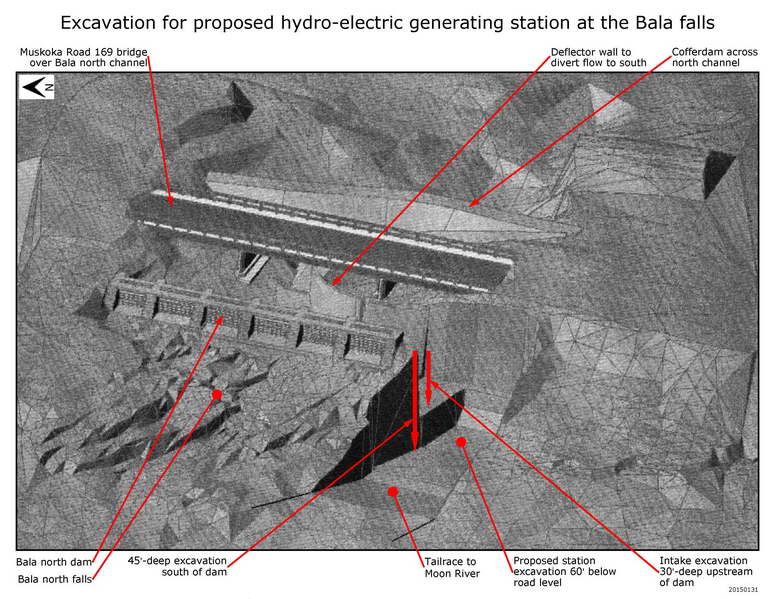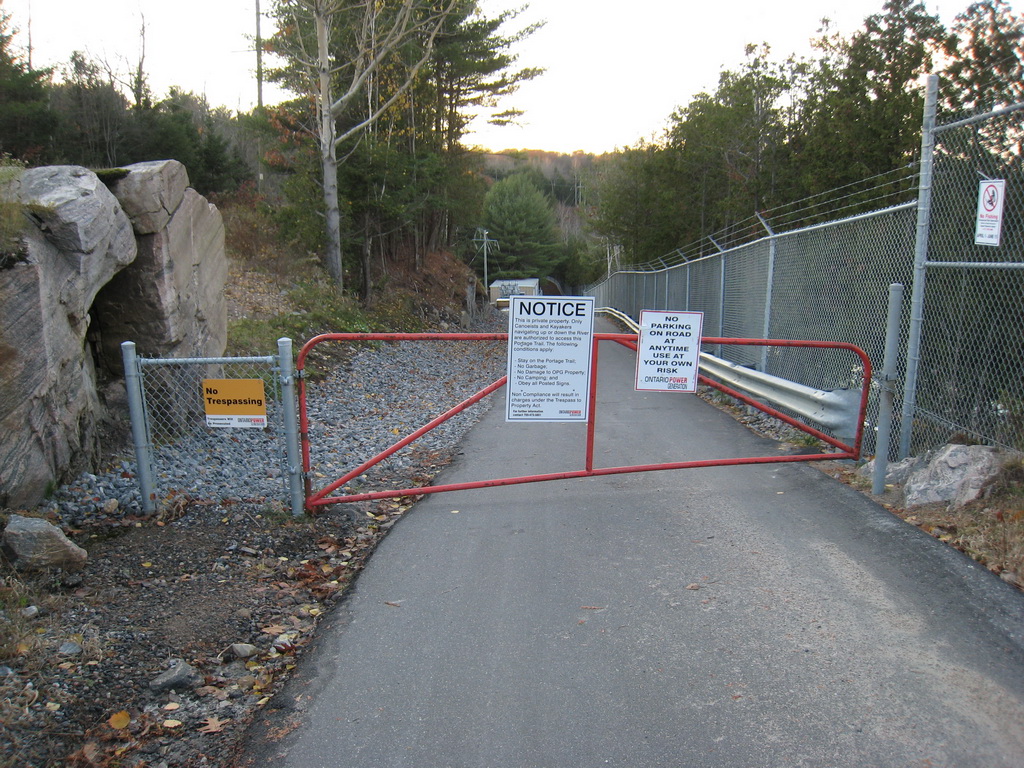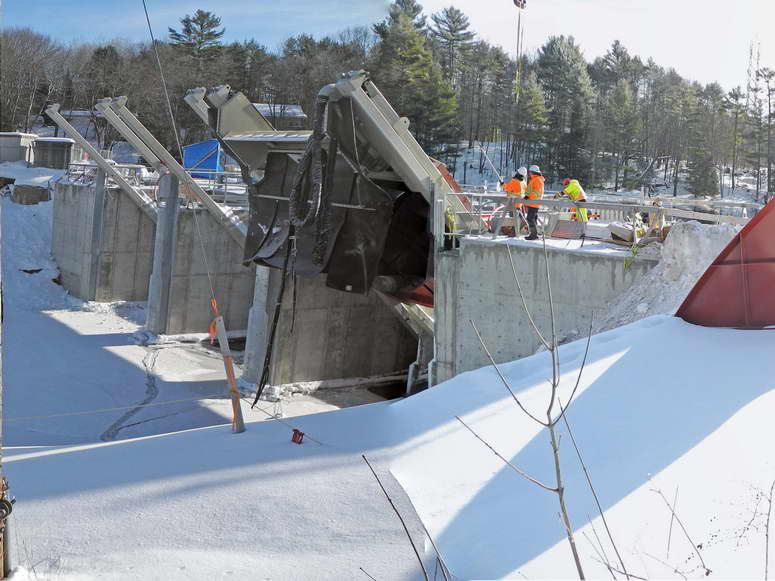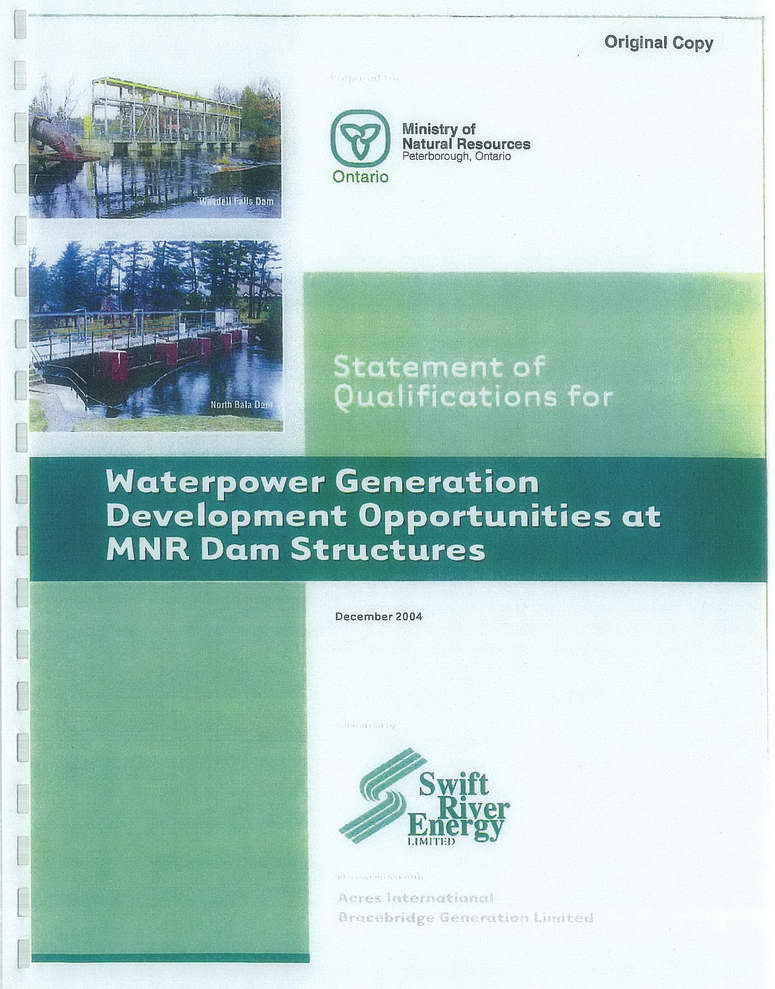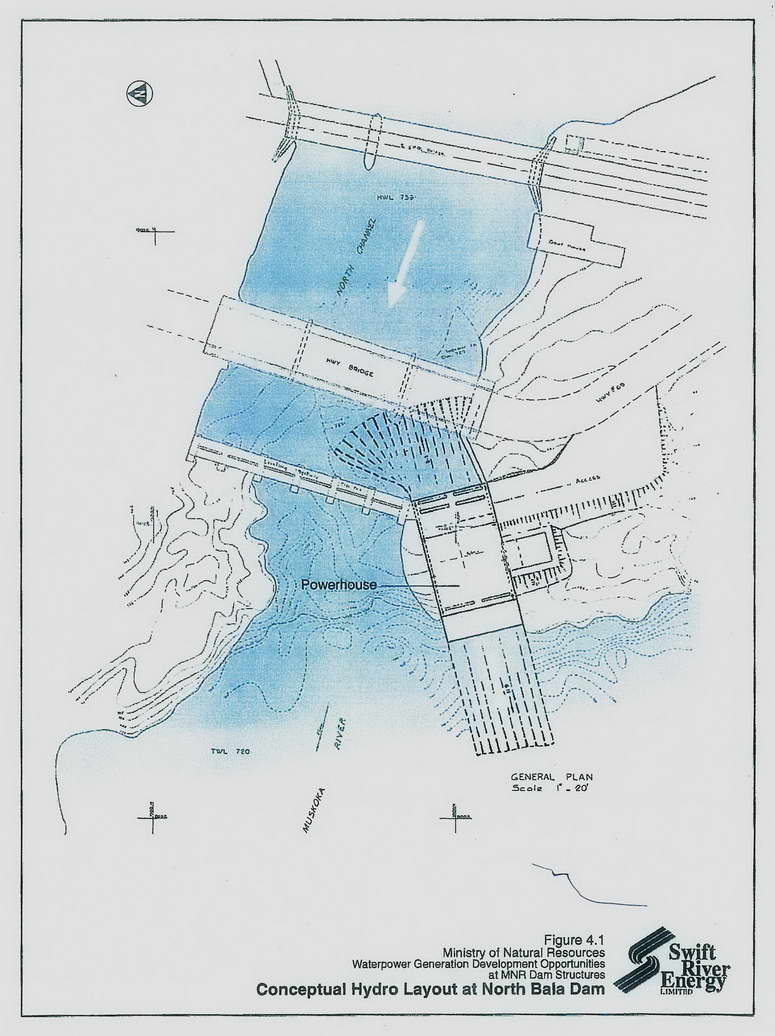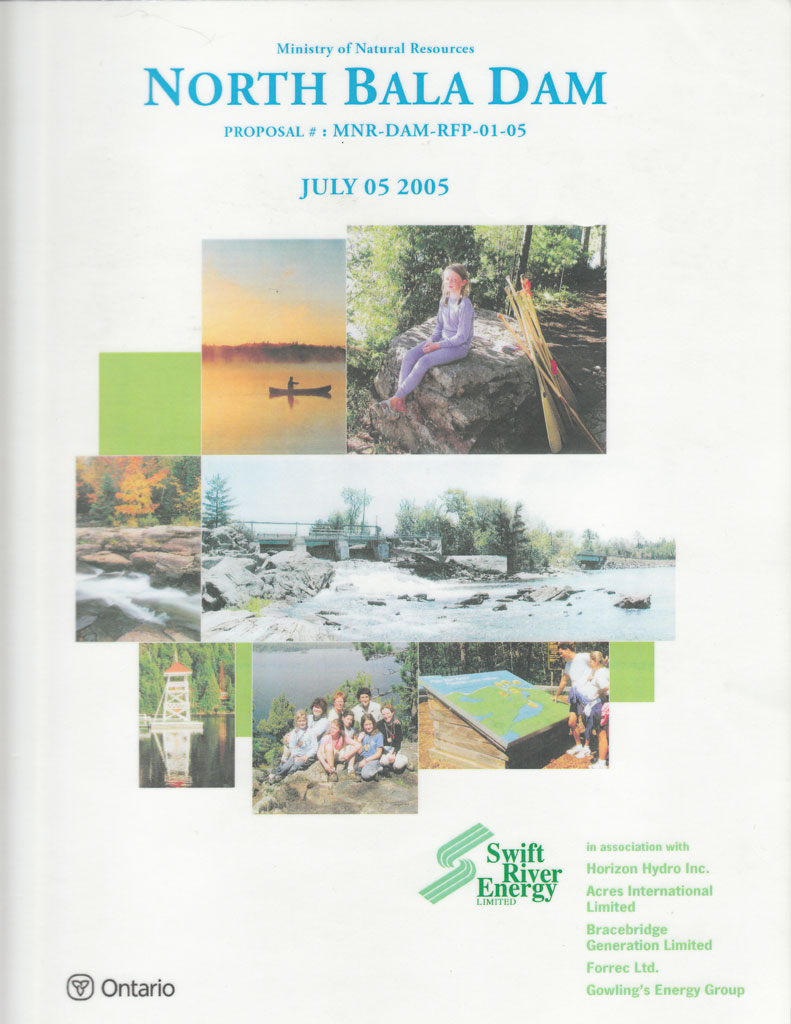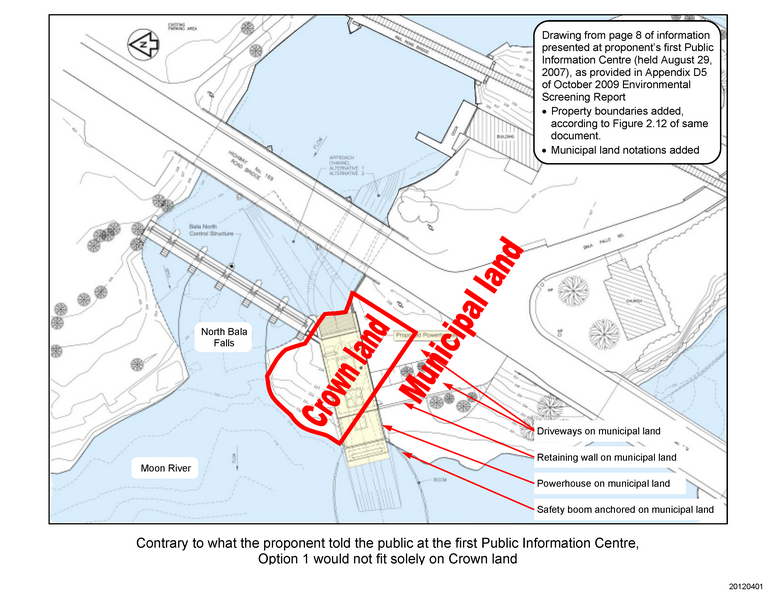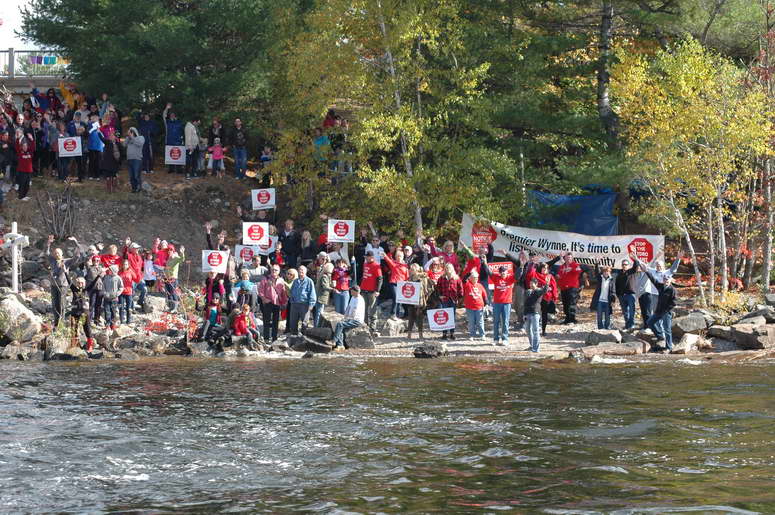We’ve all heard about the huge costs the province felt they had to (and did) pay to cancel the construction of the Mississauga and Oakville generating stations which were to be powered by natural gas. A question then is would the province have to pay to cancel the proposed hydro-electric generating station at the Bala Falls.
This process began in 2004 when the Ontario Ministry of Natural Resources began a Competitive Site Release process. The first step of this was to qualify potential bidders and this was followed by soliciting proposals by issuing a Request for Proposal (RFP) to them.
The MNR sent the proponent the RFP along with a letter dated March 7, 2005 which stated that the proponent had met the first “qualification” step. Excerpts from this RFP are at the bottom of this article.
Examining the MNR’s RFP, the proponent’s subsequent July 5, 2005 proposal, and the current situation, we note the following:
- The RFP required that proponent issue a Notice of Commencement within six months of award (that is, their being awarded “Applicant of Record” status, and so they are called the proponent).
- The MNR notified the proponent of this award in a letter dated August 9, 2005 which also noted the proponent had up to 12 months to issue the Notice of Commencement (which informs the public of the beginning the environmental assessment process). The proponent did issue a Notice of Commencement on March 8, 2006, but this stated “Public Information Centres will be scheduled to be held in Bala and Toronto during the summer of 2006”. There never was a Public Information Centre held in Toronto, and there was no Public Information Centre held in the summer of 2006. So this was an unfulfilled and meaningless Notice of Commencement.
- Another Notice of Commencement was issued on August 8, 2007, which was 24 months after award.
So this certainly did not meet the RFP requirements.
- The RFP required that the proponent issue their Environmental Screening/Review report and issue their Notice of Completion within two years of award. The proponent accepted this, as their 2005 proposal stated: “It is noted that the EA must be completed within 2 years of selection”.
- However the Notice of Completion was issued on October 9, 2009, which was more than four years after award and more than two years after the Notice of Completion.
So this certainly did not meet the RFP requirements.
- The RFP required that the proponent consider public access for traditional uses, yet their current plans would permanently obstruct and eliminate the Bala Portage, which is certainly a traditional use.
- We note the proponent accepted this obligation as their 2005 proposal stated: “… these restrictions will not generally diminish the public’s enjoyment of the area for swimming, boating, fishing, picnicking and hiking”.
So this certainly did not meet the RFP requirements and the proponent’s proposal commitments.
- The proponent’s 2005 proposal stated that: “Swift River is aware that the Bala site has substantial beauty for the local population, both permanent and summer residents, and is a tourist gem for the people of Ontario. This is clearly recognized in our proposal”. Certainly one example is that the proponent’s 2005 proposal stated their design would be: “a low-profile power house built mostly underground (bunker-type). Its roof will be below road level and only some 5 ft above ground level, creating an excellent vantage point for visitors to view the surrounding lake, falls and parkland.” Clearly these statements by the proponent would therefore have been an important factor in their being selected through the MNR’s competitive process.
However, the proponent’s drawings submitted to Transport Canada in 2014 show that in fact their design would be more than:
- 28′ above the road level (not below it).
- 10′ to 40′ above ground level, and the structure would be more than 55′ above the Moon River.
- 52′ wide, and obstruct the view down the river, and not provide any look-out or viewing platform.
We note the MNR’s RFP reserved the right to “disqualify any Applicant whose Proposal contains … materially inaccurate or misleading information”, and this certainly is significant inaccurate and misleading information (the proponent’s design reneges on many other commitments in their proposal, as shown here).
Of course, the proponent would claim the project is now far past the RFP part of the process. But the proponent chose to not conform to their own proposal for known-crucial aspects – for the same site as their original proposal. And the proponent chose to delay divulging this crucial information for so long – in fact they still have not made these dimensions public. So the proponent will have to deal with the situation they knowingly created.
In summary, the proponent has not met the reasonable and clearly stated requirements of this competitive site release process and therefore the MNR would be justified in exercising their right to cancel this process without any liability to pay or otherwise compensate the proponent for their expenses or other costs.
Excerpts from the RFP which the MNR sent to the proponent on March 7, 2005 (blue emphasis added) …
v. Site Release RFP Incorporated into Proposal
All of the provisions of the RFP are deemed to be accepted by each Applicant and incorporated into each Applicant’s Proposal.
D. Work Plan
The operator must be willing to submit Notice of Commencement within six months of award; commence an Environmental Assessment within two years of award; …
Category 2: Technical and Feasibility of Project …
The items listed below must be addressed: …
Recognition of the ‘technical’ issues. Plan to address the technical issues and the approach to deal with these issues.
The applicant will need to consider the need for scenic flows, public access for traditional uses and continuity of business in the local area.
4. The applicant will be responsible for:
c) Indemnifying the Crown against all claims, actions and/or obligations that may arise as a consequence of the operation of the dam structure
d) Operations and maintenance of the dam structure will be carried out according to current and future provincial standards. … The onus is on the applicant to examine the structures and determine the extent of repairs necessary to meet dam safety and discharge criteria consistent with the dam operational plan, any and all legal requirements and direction by the Ministry.
APPLICANT COSTS
Liability for Expenses Incurred by Applicant
… The MNR shall not be liable to pay any Applicant costs under any circumstances. In particular, the MNR will not reimburse the Applicant in any manner whatsoever in the event of rejection of any or all Proposals or submissions, or in the event of the cancellation of this Site Release RFP. By submitting a Proposal in response to this Site Release RFP, the Applicant irrevocably and unconditionally waives any claims against the MNR relating to the Applicant’s costs.
2.0 General Terms
i. Reserved Rights of the MNR
The MNR reserves the right to: …
g. disqualify any Applicant whose Proposal contains material misrepresentations or any other materially inaccurate or misleading information;
j. cancel this RFP process at any stage;
… and the MNR shall not be liable for any expenses, costs, losses or any direct or indirect damages incurred or suffered by any Applicant or any third party resulting from the MNR exercising any of its express or implied rights under this RFP.
APPENDICES TO ‘SCHEDULE A’
Appendix A: Statutory Declaration
I, •
OF THE •
IN THE •
SOLEMNLY DECLARE THAT …
2. All statements, specifications, data, confirmations, and information that have been set out in the Proposal, including, without limitation, the Technical and Financial Questionnaires, are complete and accurate in all material respects.

